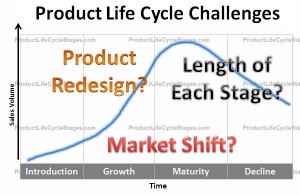 The Product Life Cycle Curve is a popular marketing model that provides manufacturers with an understanding of how they can expect their products to perform throughout their lifetime. However, it isn’t without is critics, with some arguing that there are a number of challenges with the well-recognized illustration of a product’s lifespan, and companies need to take these into account when using the model as part of their decision-making process.
The Product Life Cycle Curve is a popular marketing model that provides manufacturers with an understanding of how they can expect their products to perform throughout their lifetime. However, it isn’t without is critics, with some arguing that there are a number of challenges with the well-recognized illustration of a product’s lifespan, and companies need to take these into account when using the model as part of their decision-making process.
The Product Life Cycle Curve
To understand the challenges of using the Product Life Cycle Curve, it makes sense to look at it in a little more detail. The curve is a simple illustration that plots sales against time, providing a general picture of how a product is likely to perform through the four product life cycle stages – rising through the Introduction and Growth stages, before peaking in the Maturity stage, and eventually falling off during the Decline stage. Adaptations of the model also plot the level of profit as a second curve, which is often useful for highlighting the considerable investment and negative profits that are made in the first stage of the cycle.
What You Need to Bear in Mind
As a model, the curve provides a good approximation of the sales and profits that can be expected as products pass through the four stages of the typical life cycle. However, there are a few things to bear in mind when trying to apply the Product Life Cycle Curve in the real world.
- Unpredictability: While a product’s life may be limited, it is very hard for manufacturers to predict exactly how long it is likely to be, especially during the new product development phase. While most manufacturers are very good at making the best decisions based on the information they have, consumer demand can be unpredictable, which means they don’t always get it right.
- Change: The unpredictability of a products life span comes from the fact that all the factors that influence the product life cycle are constantly changing. For example, changes in the cost of production or a fall in consumer demand due to the launch of alternative products, could significantly alter the duration of the different product life cycle stages.
- The Curve is a Model: Critics of the product life cycle have claimed that some manufacturers may place too much importance on the suggestions the model makes, so that it eventually becomes self-fulfilling. To illustrate the point, if a company uses the product life cycle curve as a basis for its decisions, a decrease in sales may lead them to believe their product is entering the Decline stage and therefore spend less on promoting it, when the opposite strategy could help them to capture more market share and actually increase sales again.
While the Product Life Cycle Curve needs to be applied with a certain amount of care, and manufacturers are unlikely to rely solely on it’s simple illustration to predict their sales and profits, it is still a useful tool.
With a general appreciation of the kind of challenges that will be faced during each of the four stages, the model provides businesses and their marketing departments with the opportunity to be plan ahead and be better prepared to meet those challenges.

